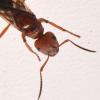Just trying to identify this queen and because it's big, it was easy to get a clear photo. Check the Google photo album below.
QUEEN ANT #1
1. Location of Collection: Surrey, British Columbia
2. Date of Collection: 2017-07-04
3. Habitat of Collection: Wandering inside a retail store (small strip mall - google map)
4.Length: around 10-11mm using a caliper
5. Coloration: black in color, dark brown around joins and antennae, bald from what i can see
6.Distinguishing characteristics: abdomen has no petiole node, smooth, 12 antennal segments.
Photo Album: https://goo.gl/photo...smc2UWevcSzm7S6
QUEEN ANT #2
1. Location of Collection: Surrey, British Columbia
2. Date of Collection: 2017-05-26
3. Habitat of Collection: local community garden caught wandering along the wood frame of a garden (google map)
4.Length: around 5mm using a caliper
5. Coloration: dark brown in color, dark yellow or light brown around joins and antennae
6.Distinguishing characteristics: abdomen has two petiole nodes, 12 antennal segments.
Photo Album: https://goo.gl/photo...6Jgj69YhzSd1RN6
Edited by proto, July 7 2017 - 4:35 PM.
















